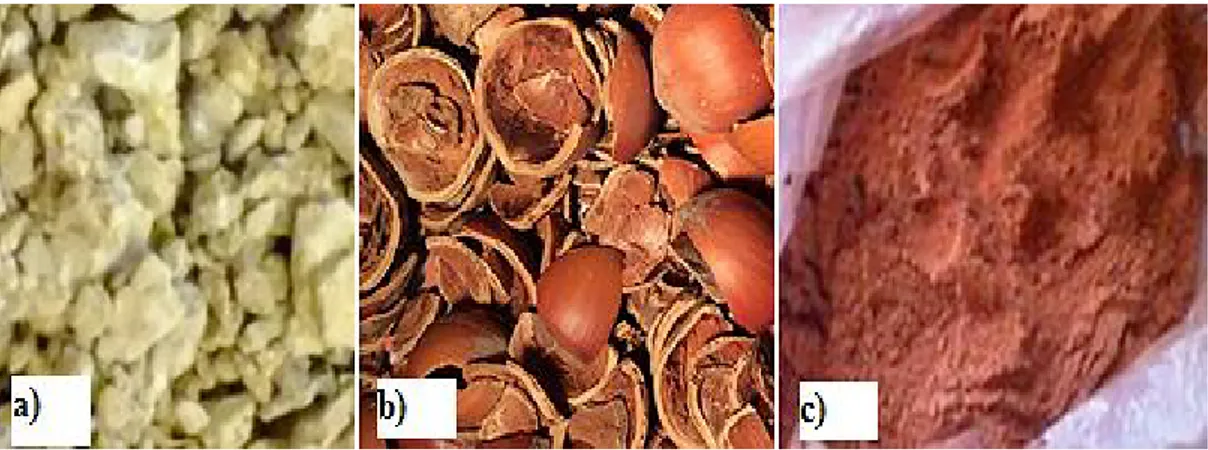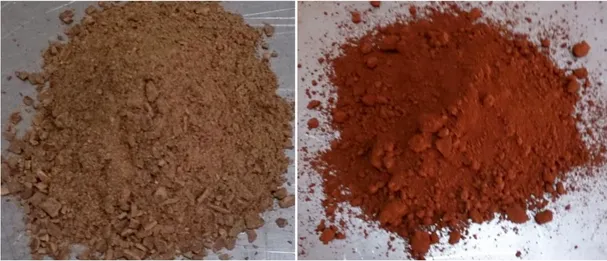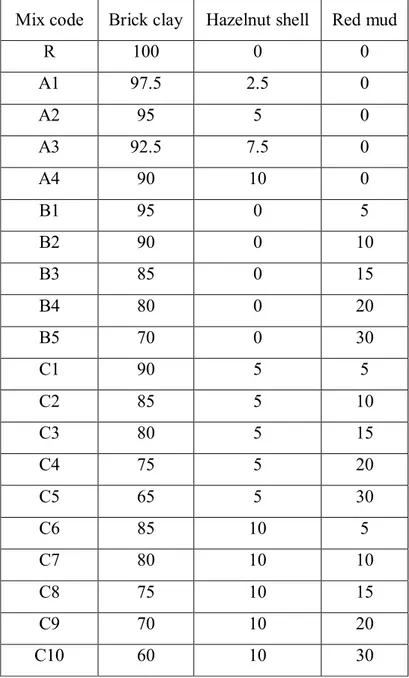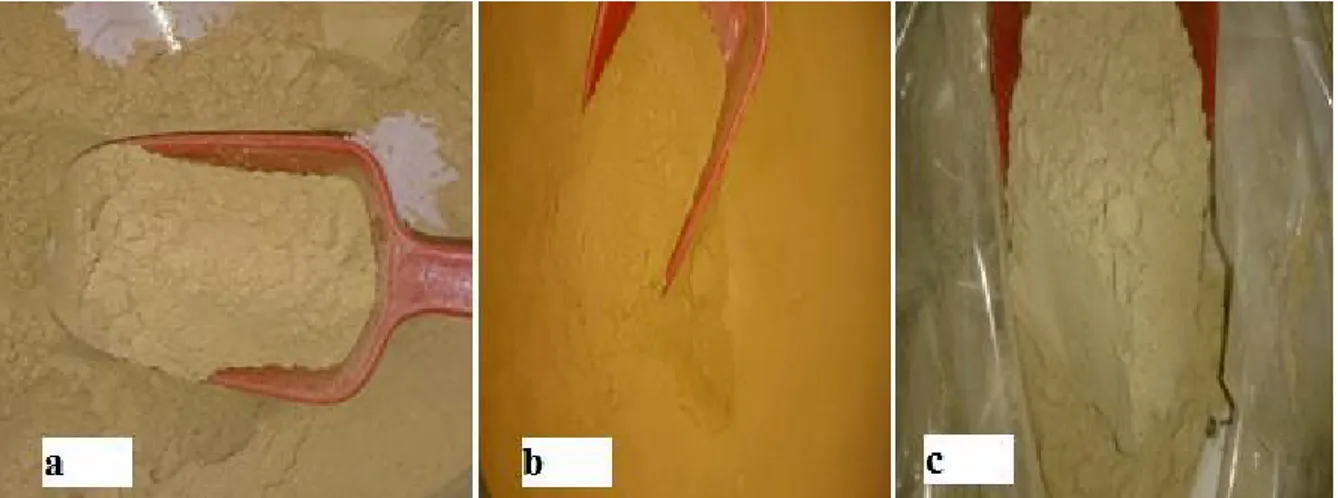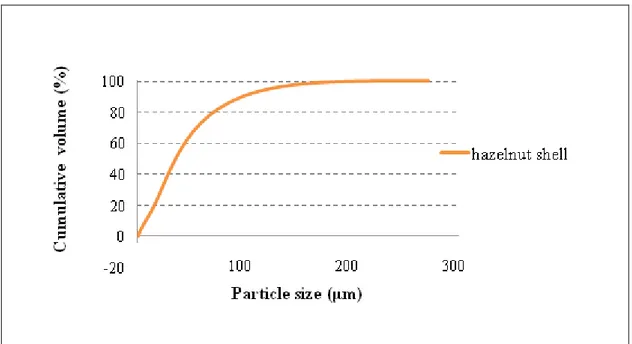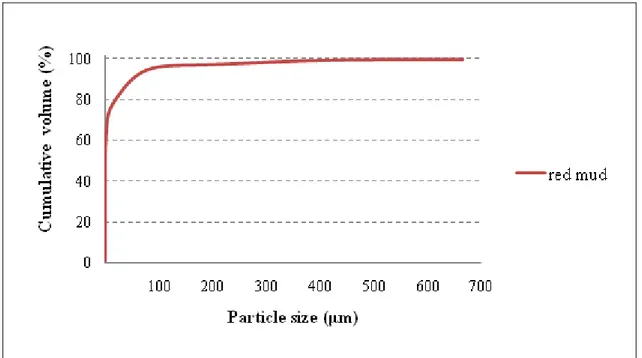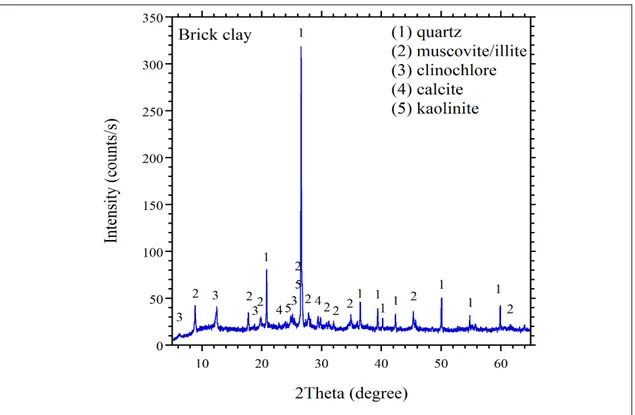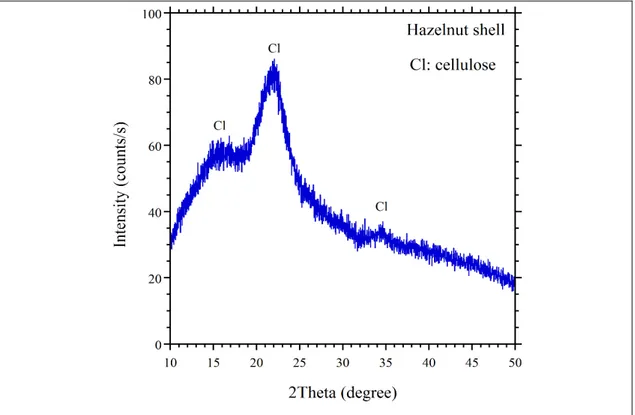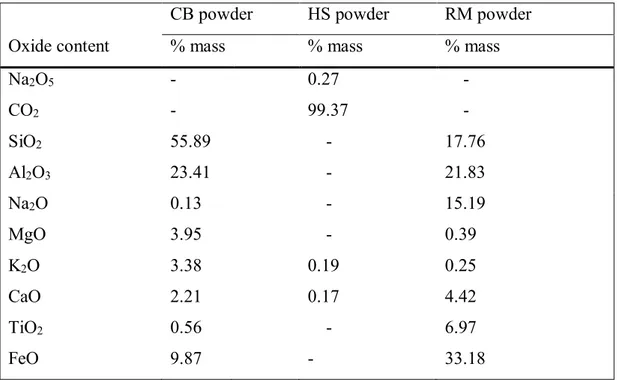İZMİR KÂTİP ÇELEBİ UNIVERSITY GRADUATE SCHOOL OF NATURAL AND APPLIED SCIENCES
CHARACTERIZATION OF CLAY BRICK MATERIALS PRODUCED WITH RED MUD AND NUT SHELL WASTES FOR BUILDING
APPLICATIONS
M.Sc. THESIS
Ata Sadık ÇAM
Department of Mechanical Engineering
Thesis Advisor: Assist. Prof. Dr. Ebubekir ATAN Thesis Co-Advisor: Assoc. Prof. Dr. Mücahit SÜTÇÜ
İZMİR KÂTİP ÇELEBİ UNIVERSITY GRADUATE SCHOOL OF NATURAL AND APPLIED SCIENCES
CHARACTERIZATION OF CLAY BRICK MATERIALS PRODUCED WITH RED MUD AND NUT SHELL WASTES FOR BUILDING
APPLICATIONS
M.Sc. THESIS
Ata Sadık ÇAM (Y130105014)
Department of Mechanical Engineering
Thesis Advisor: Assist. Prof. Dr. Ebubekir ATAN Thesis Co-Advisor: Assoc. Prof. Dr. Mücahit SÜTÇÜ
İZMİR KÂTİP ÇELEBİ ÜNİVERSİTESİ FEN BİLİMLERİ ENSTİTÜSÜ
YAPI UYGULAMALARI İÇİN KIRMIZI ÇAMUR VE FINDIK KABUĞU ATIKLARI İLE ÜRETİLMİŞ KİL TUĞLA MALZEMELERİNİN
KARAKTERİZASYONU
YÜKSEK LİSANS TEZİ Ata Sadık ÇAM
(Y130105014)
Makina Mühendisliği Anabilim Dalı
Tez Danışmanı: Yrd. Doç. Dr. Ebubekir ATAN Yardımcı Tez Danışmanı: Doç. Dr. Mücahit SÜTÇÜ
v ACKNOWLEDGEMENTS
I would like to thank my advisors, Assist. Prof. Dr. Ebubekir ATAN and Assoc. Prof. Dr. Mücahit SÜTÇÜ, for their constant support through out dissertation. I appreciate your support in every sense. I am grateful to the other committee members.
I would like to appreciate deeply my research assistant coach Savaş ÖZTÜRK, Dr. Tuncay DİKİCİ and Metehan ATAGÜR for the moments that we shared together. Finally, I would like to thank my mother heartily for her constant encouragement and support.
vii TABLE OF CONTENTS
Page
ACKNOWLEDGEMENTS ... v
TABLE OF CONTENTS ... vii
ABBREVIATIONS ... ix
LIST OF FIGURES ... xi
LIST OF TABLES ... xiii
SUMMARY ... xv
ÖZET ... xvii
1. INTRODUCTION ... 1
2. CLAY BRICK AND WASTES USED IN THIS THESIS ... 5
2.1 Clay Brick Processing ... 5
2.2 Hazelnut Shell Waste ... 7
2.3 Red Mud Waste ... 9
2.4 Literature Works for Clay Bricks with Added the Wastes ... 11
3. MATERIAL AND METHODS ... 15
3.1 Characterization of the Raw Materials ... 19
3.1.1 Particles size analysis ... 19
3.1.2 X-ray diffraction analysis ... 20
3.1.3 Microstructural analysis... 21
3.1.4 Thermogravimetric analysis ... 21
3.2 Characterization of the Fired Brick Samples ... 21
3.2.1 Physical properties ... 22
3.2.2 Thermal conductivity test ... 22
3.2.3 Mechanical analysis ... 22
3.2.4 X-ray diffraction analysis ... 23
3.2.5 Microstructural analysis... 23
4. RESULTS AND DISCUSSION ... 25
4.1 Characterization of the Raw Materials ... 25
4.1.1 Particles size analysis ... 25
4.1.2 X-ray diffraction analysis ... 26
viii
4.1.4 Thermogravimetric analysis ... 29
4.2 Characterization of the Fired Brick Samples Results. ... 32
4.2.1 Physical properties ... 32
4.2.1.1 Weight loss after firing ... 33
4.2.1.2 Apparent porosity ... 33
4.2.1.3 Water absorption ... 34
4.2.1.4 Bulk density ... 35
4.2.1.5 Apparent specific gravity ... 36
4.2.2 Thermal conductivity ... 37
4.2.3 Mechanical analysis ... 38
4.2.4 X-ray diffraction analysis ... 39
4.2.5 Microstructural analysis ... 41
5. CONCLUSIONS... 45
6. REFERENCES ... 47
ix ABBREVIATIONS
wt% : Weight percent
EN : European Standard
DE : Diatomaceous Earth
BNS : Brazil nut shell
CB : Clay brick
HS : Hazelnut shell
RM : Red mud
: Thermal conductivity coefficient
σc : Compressive strength
xi LIST OF FIGURES
Page
Figure 2.1: Manufacturing process of heavy clay products ... .6
Figure 2.2: Percentage of Turkish hazelnut production in the world ... .8
Figure 2.3: A schematic representation of the Bayer process ... .11
Figure 2.4: Porosity and compressive strength for DE+BNS ash ... .12
Figure 3.1: Raw materials for a) clay, b) hazelnut shell and c) red mud ... .15
Figure 3.2: Experimental flow-chart for sample preparation ... .16
Figure 3.3: Ring grinding mill ... .17
Figure 3.4: 900 rpm and 2 min grinding for hazelnut shell and red mud ... .17
Figure 3.5: 1000 rpm and 2 min grinding for hazelnut shell and red mud ... .17
Figure 3.6: Retsch AS200 sieving device ... .20
Figure 3.7: a) Hazelnut shells powder (HS) below 100 µm, b) Red mud powder (RM) below 100 µm and c) Clay brick powder (CB) below 125 µm ... .20
Figure 3.8: a) Dried samples, b) Fired samples ... .21
Figure 3.9: Bruker D2 Phaser device ... .23
Figure 4.1: Particle size analysis of hazelnut shell powder ... .25
Figure 4.2: Particle size analysis of red mud powder ... .26
Figure 4.3: Particle size analysis of clay raw material powder ... .26
Figure 4.4: XRD patterns for powdered brick clay ... .27
Figure 4.5: XRD patterns for powdered red mud ... .27
Figure 4.6: XRD patterns for powdered hazelnut shell ... .28
Figure 4.7: SEM micrographs of a) the clay powder (CB powder), b) hazelnut shell powder (HS powder) and c) red mud powder (RM powder) ... .28
Figure 4.8: Thermogravimetric analysis (TGA) curve of the hazelnut shell ... .30
Figure 4.9: Thermogravimetric analysis (TGA) curve of the clay raw material ... .31
Figure 4.10: Thermogravimetric analysis (TGA) curve of the red mud . ... .32
Figure 4.11: Weight loss of the produced bricks after firing ... .33
Figure 4.12: Apparent porosity values of the produced bricks ... .34
Figure 4.13: Water absorption values of the produced bricks ... .35
Figure 4.14: Bulk density values of the produced bricks ... .36
xii
Figure 4.16: Thermal conductivity values of the produced bricks ... .38
Figure 4.17: Compressive strength values of the produced bricks ... .39
Figure 4.18: XRD pattern of A4 brick sample fired 1000°C ... .39
Figure 4.19: XRD pattern of B5 brick sample fired 1000°C ... .40
Figure 4.20: XRD pattern of C10 brick sample fired 1000°C ... .41
Figure 4.21: Samples taken bakelite for microstructural investigations ... .41
Figure 4.22: ZSM micrographs of a) brick clay for 900°C, b) brick clay for 1000°C, c)A4 series for 900°C, d) A4 series for 1000°C, e) B5 series for 900°C, f) B5 series for 1000°C, g) C10 series for 900°C and h) C10 series for 1000°C ... .42
Figure 4.23: SEM micrographs of a) the raw material for 1000°C, b) A4 series for 1000°C, c) B5 series for 1000°C, d) C10 series for 1000°C and e) C10 series for 100°C (drying) ... .43
xiii LIST OF TABLES
Page
Table 2.1: Limited data concerning the heavy clay industry worldwide ... .7
Table 2.2: An example of hazelnut shell ash compositions ... .9
Table 2.3: Some studies about fired brick with waste materials ... .13
Table 2.4: Compressive strength of red mud based brick samples ... .14
Table 3.1: Waste added brick mixtures prepared in this study (wt%) ... .18
Table 4.1: EDS results of the raw materials ... .29 Table 4.2: EDS results of reference brick, A4, B5, C10 (firing) and C10 (drying) .44
xv SUMMARY
CHARACTERIZATION OF CLAY BRICK MATERIALS PRODUCED WITH RED MUD AND NUT SHELL WASTES FOR BUILDING
APPLICATIONS
In this study, clay based brick with micro pores was developed for thermal insulation in the building materials. Turkey produces about 70% of the world hazelnut production. The aim of this thesis is to reduce the thermal conductivity coefficient by adding organic waste (hazelnut shell) into clay mixture to form porosity during firing of clay bricks. Moreover, it is to maintain the similar mechanical properties by adding inorganic waste (red mud) into clay mixture. The development of a highly porous bricks with applicable mechanical strength will contribute to save energy in the building. The physical, mineralogical, microstructural, thermal and mechanical properties of bricks contributing waste were investigated. Clay based brick structures which are produced from ceramic raw materials that have large compositions, can tolerate many waste materials with similar composition. Low water content (about 15% by weight) were applied to the clays used in the mixtures. In this work, dry brick mixtures were prepared by adding (2.5%, 5%, 7.5% and 10% by weight) hazelnut shell and (5%, 10%, 15%, 20% and 30% by weight) red mud to the clay. The mixtures containing brick clay with hazelnut shell and red mud addition were prepared in a mechanical mixer. The mixtures were pressed, dried and then fired to obtain the highly porous durable structure. Highly porous ceramics from the mixtures with up to 10% hazelnut shell and up to 30% red mud addition was successfully produced. Thermal conductivities of the samples decreased from 0.78 W/mK (1.80 g/cm3) to 0.45 W/mK (1.41 g/cm3) with increasing hazelnut shell and red mud addition. The lowest compressive strength of 9.12 MPa was found, it is appropriate for usage. This study is an important study for recycling of waste in the thermal insulating lightweight brick production.
xvii ÖZET
YAPI UYGULAMALARI İÇİN KIRMIZI ÇAMUR VE FINDIK KABUĞU ATIKLARI İLE ÜRETİLMİŞ KİL TUĞLA MALZEMELERİNİN
KAREKTERİZASYONU
Bu çalışmada, yapı malzemelerinde ısı yalıtım amaçlı kullanılacak mikro gözeneklere sahip kil esaslı tuğla malzemeleri geliştirilmiştir. Türkiye, dünya fındık üretiminin yaklaşık % 70'ini üretmektedir. Bu tezin amacı, kil tuğlalarda pişirme sürecinde bir organik (fındık kabuğu) atığının gözenek yapıcı olarak kullanılması ile ısı iletim katsayısının düşürülmesidir. Ayrıca kil karışımına inorganik atık (kırmızı çamur) katkısıyla mekanik özelliklerinin uygun seviyelerde tutulmasıdır. Yüksek miktarda gözenekli ve kullanılabilir mekanik dayanıma sahip tuğlaların geliştirilmesi tuğlanın kullanılacağı ortamda enerji tasarrufu sağlayacaktır. Atık katkılı yapı tuğlalarının mineralojik, mikroyapısal, fiziksel, mekanik ve ısıl özellikleri araştırılmıştır. Seramik malzeme olan kil esaslı tuğla ürünler, geniş kompozisyonel hammaddelerden üretildikleri için bu atıkları bünyesinde tolere edebilecek malzemelerdir. Karışımlarda kullanılan killere düşük su içeriği (ağırlıkça takriben %15) uygulanmıştır. Bu çalışmada, kuru hammadde karışımları ağırlıkça (%2.5, %5, %7.5 ve %10) fındık kabuğu ve (%5, %10, %15, %20 ve %30) kırmızı çamurun kile eklenmesiyle hazırlanmıştır. Fındık kabuğu ve kırmızı çamur ilavesi ile tuğla kil içeren karışımlar mekanik bir karıştırıcıda hazırlanmıştır. Karışımlar preslenmiş, kurutulmuş, pişirilmiş ve böylece gözenekli ve kullanılabilir dayanımda yapılar elde edilmiştir. Ağırlıkça %10 fındık kabuğu ve %30 kırmızı çamur ilavesiyle hazırlanan karışımlardan oldukça yüksek gözenekli seramikler başarıyla üretilmiştir. Örneklerin ısıl iletkenlik katsayıları fındık kabuğu ve kırmızı çamur ilavesinin artmasıyla 0.78 W/mK (1.80 g/cm3)’den 0.45 W/mK (1.41 g/cm3)’e düşmüştür. En düşük basma dayanımı, 9.12 MPa bulunmuş ve bu değer kullanım için uygundur. Bu çalışma, hem atık geri dönüşümü, hem de hafif, ısı yalıtım amaçlı yapı malzemelerinin geliştirilmesine yönelik önemli bir çalışmadır.
1 1. INTRODUCTION
In this study, clay based brick with micro pores was developed for thermal insulation in the building materials. The aim of this thesis is to reduce the thermal conductivity coefficient by adding organic waste (hazelnut shell) into clay mixture to form porosity during firing of clay bricks. Moreover, it is to maintain the similar mechanical properties by adding inorganic waste (red mud) into clay mixture. The physical, mineralogical, microstructural, thermal and mechanical properties of bricks contributing waste were investigated.
Today, energy conservation and energy efficiency is one of the most important problems in our country. Turkey is a country which imports 70% of the energy. One-third of total energy is used in buildings for heating and cooling. Twenty five percent of energy loss of buildings is from the walls. Those large amounts of this heat loss in buildings gradually increase the amount of energy consumed. Reducing the thermal conductivity coefficient of building material is one of the most important items on construction sector [1].
Organic and inorganic wastes cause severe environmental pollution, destroy great areas for dumping and increase the additional costs for disposal. The utilization of waste materials in brick-making solves some ecological problems and also decreases the use ofclean clay mineral source [2].
Red mud is an industrial inorganic residue that result from aluminium production. Approximately 1.0–1.5 tonnes of red mud residue are produced for each tonne of alumina and therefore, millions of tonnes of caustic red mud must be disposed annually worldwide [3]. Using of red mud in different application can reduce environmental pollution.
Heavy clay materials have been used to buildhouses for thousands of years. Long ago, man used sun-dried adobe bricks to build walls and then made fired clay bricks. The Assyrian ziggurats, the ramparts of Babylon, made of fired bricks laid with bitumen, the Roman baths, Sainte-Sophia and its dome in İstanbul, Albi cathedral in
2
France, the Kremlin in Moscow, the great wall in China, the temples of Pagan in Myanmar, mausoleum and minarets in Bacharach Uzbekistani, the great dome of the cathedral in Florence or the city of Venice are but a few of the best-known examples, in different places and climates [4].
These materials have been adapted to team changes in building and its demands, both in the traditional range and in the industrialized area. A hundred and fifty years ago, there was major growth in the levels of use bricks in industrial buildings, in compound with metal reinforcements. Later on, bricks were adapted for use in putting up housing for working-class people in the inside suburbs. Today, they combine the functions of structure, filling, thermal and noise insulation and also fire protection. They are very popular as a material for housing [4].
The generation of industrial materials are quickly running out of natural raw materials with heavily increased resources, emerges after significant amounts of waste production and consumption are causing environmental problems. Decrease of natural sources of raw materials necessitates the re-evaluation of industrial solid waste [5].
Clay based bricks are commonly used as construction material around the world. Recently, in many countries of the world, there is a shortage of natural source material for manufacturing of the conventional bricks. Therefore, some countries such as China are supporting the use of waste materials in brick production.To support the production and application of brick materials by using of organic and inorganic wastes, there is need to develop of applicable standards. Since the present brick manufacturers have some habits they can not give up in the traditional brick manufacturing process.Their interest in the use of new technologies and the production ofinnovative and environmentally friendly green bricks from waste materials should be increased. There are need to domanystudies about the technical, economic and environmental aspects, andin addition, the government policy and public education related to waste recycling and sustainable development for supporting the production and application of bricks produced from wastes [6].
Brick material is one of the significant material groups used for construction and building industry. The conventional manufacturing procedure of bricks from the point of view raw material and its classical shape models has left this important
3
material away in advancement. In addition to residential and industrial buildings, this building material is used in large quantities in facilities used for substructure, water and sewage. Particularly in the last decade there has been a discrepancy between the supply and demand management of these materials, as there is great demand for the construction industry due to the growing population. In order to meet ever-increasing demands, researchers are trying to design and develop sustainable alternative solutions for construction materials. The increasing popularity of environmentally friendly, low-cost, and lightweight materials in the building industry needs to be investigated as to how to achieve and confirm the material requirements that are validated in the standards as well as being beneficial to the environment. Brick is one of the most suitable wall materials as building material because of its advantageous features in terms of fire-proofing, thermal and sound insulation, heat and humidity comfort and also long-term durability. Recently, some researchers have made many studies about the use of various wastes with organic and inorganic content in the manufacture of bricks; for instance, the use of paper processing waste, kraft pulp production residue, waste paper pulp, wet pomace, cotton waste, wood sawdust, straw, processed waste tea, cigarette butts, rice husk ash, fly ash, limestone dust, marble waste, granulated blast furnace slag, welding flux slag, rubber, textile effluent treatment plant sludge, industrial waste water treatment sludge, petroleum effluent treatment plant sludge, polystyrene foam and plastic fiber etc. [7,8].
5
2. CLAY BRICK AND WASTES USED IN THIS THESIS
This study covers the manufacturing and characterizations of porous and lightweight clay bricks withlow thermal conductivity and acceptable mechanical strength. To gain these properties, the hazelnut shell as organic waste and red mud as inorganic waste were used. These wastes were mixed in clay materials in certain amounts and then these mixtures were pressed and fired to obtain strong body. The products were characterized for physical, thermal and mechanical properties.
Hazelnut shells are generally used as fuel due to their high calarofic value [9]. With the rise of large quantities of industrial development in recent years, the detrimental effects of waste in the environment have been increased. The red mud and fly ash are examples of this type of waste from aluminum production processing and thermal power plants, respectively. Usually they accumulate in large volumes in landfills. The disposal of this wasteis a huge burden, both from the economic and environmental aspects [10,11,12].
Many of inorganic waste can be reusable in ceramic production because of their similar inorganic contents to ceramic structure. Also many of organic waste can be used as pore-making agent in ceramic production.
In this thesis, the hazelnut shell as organic waste and red mud as inorganic waste were used in clay brick production.
2.1 Clay Brick Processing
The main steps of clay brick process is provided, respectively; - The preparation of raw materials (grinding, sieving)
- Preparation of the clay mixture (mixing)
- Shaping the products (pressing, extrusion or handmade) - Drying
6 - Testing and characterization
Figure 2.1 shows the manufacturing process for heavy clay brick.
7
Heavy clay is widely used all over the world with different level of developments and technologies. Table 2.1 gives some production data that show the great significance of bricks in numerous countries, together with the very wide variety of levels of developments concerning the technologies used and the productivity. The total amount of brick manufacturing is about 3 billion tonnes in the world [4].
Table 2.1: Limited data concerning the heavy clay industry worldwide [4].
Country Production (millions of tonnes) Number of housing units per year (thousands) Number of factories (thousands) Population (million) China 1.300 25.000 90 1.290 India 360 50 1.057 Brazil 100 5.5 182 Europa 90 2.275 1.5 360 Iran 23.4 0.9 64 USA 19 2.000 0.2 290 Pakistan 18 >3 160 Russia 16 510 144 Maghreb 14 0.42 72 Turkey 12.4 360 68 South Africa 10 44
2.2 Hazelnut Shell Waste
Turkey produces about 70% of the world hazelnut production. Most of these production is on the western Black Sea region [9]. The hazelnut production area of the world is about 900 hectares, 700 hectares of these is in our country. In the 2014/2015 season, 400 tons out of total 650 tons hazelnuts has produced in Turkey
8
[13]. The amount of the shell may assumed approximately 200 tons. Figure 2.2 shows Turkish hazelnut production.
Figure 2.2: Percentage of Turkish hazelnut production in the world [13]. In this study, our aim is to use this huge amount of waste in brick manufacturing to benefit for economic and environmental aspects. The hazelnut shell provides reduce the amount of clay raw materials, creates micro porosity during firing into brick body which decrease thermal conductivity. Also these waste usage offers additional heat source fuel. All these benefits make these materials attractive for use in bricks [14]. In the literature there is no study about usage of hazelnut shell as additive in the brick production found yet. Average ash compositions or weight (wt%) dry basis of sample results of hazelnut shells given in Table 2.2. This ash contain mainly potassium oxide (K2O), quartz (SiO2), calcium oxide (CaO), magnesium oxide (MgO) and minor other oxides components [15].
9
Table 2.2: An example of hazelnut shell ash compositions [15].
2.3 Red Mud Waste
Red mud is a waste generated by the Bayer process and its disposal to environment is a major problem.Waste red mud from Eti Seydişehir Aluminium Plant of Turkey was considered as a dangerous waste for the environment and human health. The storage of the red mud is difficult due to its high amount of differentmetal oxides, elements and caustic content. The environmental compliance tests are evaluated according to the “Regulation on Regularly Storage of Waste” of the colored concretes produced
Compositions Hazelnut shell ash (% by weight) SiO2 27.3 Al2O3 3.1 Fe2O3 3.8 CaO 15.4 MgO 7.9 TiO2 0.1 Na2O 1.3 K2O 30.4 SO3 1.1 P2O5 3.2 Undetermined 6.4
10
from red mud. According to the study given in this literature, test results; red mud, a hazardous waste alone, can be used in the city furniture manufacture. The city furnitures manufactured with red mud does not contain hazardous substances. Also, these city furnitures can be stored as safe substances with “Regulation on Regularly Storage of Waste in Turkey”. City furnitures manufactured with red mud preserving coloring properties at +40ºC/-10ºC for 1 year period [16].
The red-mud obtained during the manufacture of aluminium from bauxite ore as a by-product contains valuable materials such as iron, aluminum, sodium, vanadium, titanium etc. [17]. Red mud is a waste material generated by the Bayer Process widely used to manufacture alumina from bauxite throughout the world. Approximately, 35% to 40% per ton of bauxite operated using the Bayer Process ends up as red mud waste [18,19]. Aluminium metal is commercially produced from bauxite ore mainly through two process steps. As seen from Figure 2.3, alumina is obtained by the Bayer process.
The changes took place in brick properties by addition of red mud into the brick clay have been investigated. Currently, it has been used in many applications including cement and brick manufacture and as a filling in road works [20,21].
Nevertheless, limited sources of countries can not be evaluated completely and human power and / or economic values have been lost. These results are much more important especially in developing countries like ours [22].
11
Figure 2.3: A schematic representation of the Bayer process [19]. 2.4 Literature Works for Clay Bricks with Added the Wastes
There is no study found in the literature about the use of hazelnut shell in brickproduction. The study of the ash composition of hazelnut shell is described above.
Some researchers studied about the production of porous brick material from diatomaceous earth (DE) and Brazil nut shell (BNS) ash. They achieved the compressive strength (8.5 MPa), low thermal conductivity (0.20 W/mK), low density (1.06 g/cm3) and high porosity (49%) for a fired brick with 10% hazelnut ash at
12
850°C. As seen from Figure 2.4, the best combination of strength and porosity was achieved for a mixture of 10 wt% of BNS ash in the diatomaceous earth sintered at 850°C [14,15].
Figure 2.4: Porosity and compressive strength for DE+BNS ash [14].
From the above literature reviews some results have been compiled as follows; Water absorption is usually in the range 8-15% by weight in brick with red mud [22]. In another water absorption of the samples increased from 16.7% to 40.4% with increasing paper waste addition up to 30 wt% [5]. In addition, the thermal conductivities of the samples decreased 0.25 W/mK to 0.13 W/mK with decreasing their density [5]. Likewise, water absorption of the samples increased from 17% to 31% with increasing wet pomace [8]. Table 2.3 gives some studies about fired brick with waste materials.
13
Table 2.3: Some studies about fired brick with waste materials.
Another work [22], brick samples were prepared by adding 85, 90 and 95 wt% red mud to the clay without additional water. The lowest compressive strength of 20.5
Ref
No. Waste material Shaping
Size of brick mold(mm) Firing Testsconducted 5 Paper processing residues, (up to 30 wt%) Pressing 85x85x10 2.5°C/min up to 600°C then 10°C/min up to 1100°C Bulk density, apparent porosity, water absorption, compressive strength and thermal conductivity 8 Wet pomace, (up to 25 wt%) Pressing 60x30x10 Up to 950°C in 24 h thermal cycle Apparent density, water absorption, compressive strength and thermal conductivity 14 Brick material from diatomaceous earth and Brazil nut shell
ash (up to 30 wt%) Pressing 35 mm in diameter and 35 mm in length 750, 850 and 950°C 5°C/min and a holding time of 1 h Bulk density, porosity, thermal conductivity, compressive strength 20
Red mud into the brick body (up to 10 wt%) Extrusion 25 mm in diameter cylindrical 800, 900 and 1000°C Compressive strength, porosity and water absorption 22
Red mud into the brick body (up to 95 wt%) Pressing 50x8x12 700, 800 and 900°C for 1 h Bending strength, compressive strength and water absorption
14
MPa was found. As seen from Table 2.4, red mud additive have an effect to decrease the compressive strength of bricks.
Table 2.4: Compressive strength of red mud based brick samples [22].
Specimens fired at 900°C 15% Clay waste
85% Red mud
10% Clay waste 90% Red mud
5% Clay waste 95% Red mud
Compressive strength (MPa) 41.5 38.2 20.5
Another study have made about brick with red mud additive. The red mud addition cause to increase compressive strength significantly. Up to %10 red mud addition partially decreases porosity and water absorption values. Optimal firing temperature of the samples was determined as 900°C [20].
The purpose of this thesis is to reduce the thermal conductivity coefficient by adding organic waste (hazelnut shell) in to clay mixture to form porosity during firing of clay bricks. Moreover, it is to improve the mechanical properties by adding inorganic waste (red mud) in to clay mixture as given in the beginning.
15 3. MATERIAL AND METHODS
In this study, production of bricks from mixtures of raw material (brick clay) and additives containing hazelnut shell and red mud was accomplished. Brick clay as raw material and hazelnut shell and red mud as waste materials were used for brick production as shown in Table 3.1. Clay raw material was obtained from Yüksel Tuğla Kiremit plant in Turgutlu, Turkey. Hazelnut shells from Ordu (Turkey) and red mud waste from Seydişehir Aluminum Plant (Konya, Turkey) was obtained. The raw materials of clay (CB), hazelnut shell (HS) and red mud (RM) are shown in Figure 3.1. Experimental flow-chart for brick sample preparation is shown on Figure 3.2.
16
Figure 3.2: Experimental flow-chart for sample preparation.
The raw materials were dried for 20 hours at 50 °C, then 4 hours at 100 °C. In Figure 3.3, dried powder were initially subjected to pre-treatments such as grinding by using a ring mill equipment Retsch RS 200 model. Thereafter, they were pulverized at 900 rpm, then at 1000 rpm for 2 minutes each. Figure 3.4 and 3.5 shows the ground hazelnut shell and red mud powders at 900 rpm and 1000 rpm for 2 min., respectively. Screening is used for the classification of dry material in powder form dimensionally.
Brick Clay+HazelnutShell+Red Mud
Powder Mixing Semi-dry Pressing Drying Firing Brick Characterization Water Spraying
17
Figure 3.3: Ring grinding mill.
Figure 3.4: 900 rpm and 2 min grinding for hazelnut shell and red mud.
18
Low water content (about 15% by weight) were applied to the clays used in the mixtures. In this work, dry brick mixtures were prepared by adding (2.5%, 5%, 7.5% and 10% by weight) hazelnut shell and (5%, 10%, 15%, 20% and 30% by weight) red mud to the clay. The mixtures containing brick clay with hazelnut shell and red mud addition were prepared in a mechanical mixer.
Waste added brick mixture proportions were presented in Table 3.1. R series is reference brick, A series is brick with added HS, B series is brick with added RM and C series is brick with added HS and RM.
Table 3.1: Waste added brick mixtures prepared in this study (wt%). Mix code Brick clay Hazelnut shell Red mud
R 100 0 0 A1 97.5 2.5 0 A2 95 5 0 A3 92.5 7.5 0 A4 90 10 0 B1 95 0 5 B2 90 0 10 B3 85 0 15 B4 80 0 20 B5 70 0 30 C1 90 5 5 C2 85 5 10 C3 80 5 15 C4 75 5 20 C5 65 5 30 C6 85 10 5 C7 80 10 10 C8 75 10 15 C9 70 10 20 C10 60 10 30
19
Slurry was blended with industrially used hazelnut shell and red mud powder in Ika Eurostar mixer at a mixing speed 200–350 rpm for 30 min. During mixing, the water about 15% of total weight (15 wt%) was sprayed to the powder mixtures for the production of semi-dry molded brick samples. The granulated powder mixtures were uniaxially compacted in hydraulic press at a pressure of 10 MPa for the circular-shaped specimens which the 20 mm diameter and the 8.56 mm-13.60 mm length. Then the drying process is applied to specimen at ambient temperature. Moreover, dried specimens were fired in a laboratory-type electrical furnace consecutively at the incremental temperature rate of 2.5 °C /min up to 600°C, at the rate of 5°C/min up to 900 and 1000°C, then holded in this temperature for 2 h.
The planned project consists of 2 main parts: characterization of the raw materials and characterization of the fired brick samples are the subject heading.
3.1 Characterization of the Raw Materials
The bricks loss on ignition was calculated by using the equation given below.
[weight loss, % = 1 2 1 100 w w w ]
Where w1, is first weight of brick specimen after firing and w2, is first final weight of brick specimen.
3.1.1 Particles size analysis
Particle size measurement technique depends on the specific parameters used in the measurement process and the particle shape [25]. The raw materials subjected to disc milling were initially sieved with Retsch AS200 sieving device (Figure 3.6) to eliminate coarse particles. Then, the particle size distribution analysis of the raw materials was made on a Malvern Mastersizer-3000 device.
20
Figure 3.6: Retsch AS200 sieving device.
The sieved raw particles used in brick pressing process are shown in Figure 3.7 respectively, hazelnut shells and red mud below 100 µm and clay brick powder below 125 µm.
Figure 3.7: a) Hazelnut shells powder (HS) below 100 µm, b) Red mud powder (RM) below 100 µm and c) Clay brick powder (CB) below 125 µm. 3.1.2 X-ray diffraction analysis
Raw materials were characterized by X-ray diffraction (XRD) analysis (Bruker D2 Phaser) to determine its mineral phase content. The mineral compounds of the brick clay, red mud and hazelnut shell powders were investigated by using XRD characterization methods with CuK radiation (=1.5406 Å) at 30 kV in the 2 intervals of 5–80.
21 3.1.3 Microstructural analysis
The microstructure of the samples was observed by means of a scanning electron microscope (SEM). In addition, SEM images of the bricks were measured by FEI/Quanta Feg 250.
3.1.4 Thermogravimetric analysis
Thermal properties of the raw materials were investigated by thermo-gravimetric analysis (TGA). These tests were carried out to evaluate the behavior of raw materials during firing. The thermo-gravimetric analysis (TGA) of raw materials was carried out by using Perkin-Elmer STA8000 instrument. The raw materials were heated to elevated temperatures (900-1100°C) at 10°C/min in nitrogen atmosphere with a purge rate of 20 ml/min, respectively.
3.2 Characterization of the Fired Brick Samples
Dried and fired samples at 900 and 1000°C were shown in Figure 3.8. To these samples, following characterization methods were applied:
Figure 3.8: a) Dried samples, b) Fired samples.
900°C
22 3.2.1 Physical properties
The physical properties of the samples after firing were characterized. Bulk density, apparent porosity, water absorption and apparent specific gravity values of the fired samples were measured by Archimedes method according to ASTM C20 standard (2005). First, the fired brick samples boiled in water for 2 hours then cooled to room temperature and kept in water about 12 hours before weighing as defined in the literature [26]. During the boilingand cooling period, the specimen entirely covered with water, and no contact with the bottom of the container.
Porosity is one of the main parameters which establish the properties of fired bricks and has a direct effect on reduction of thermal conductivity and bulk density [27]. However, too much reduction in density could lead to structural and mechanical defects. Recommended bulk density for a traditional brick is between 1.8 and 2.0 g/cm3 [28].
3.2.2 Thermal conductivity test
In this thesis, thermal conductivity coefficient () of the brick specimens was measured by C-Therm TCi Thermal Conductivity Analyzer with modified transient plane source. This technique is noted to be an effective and accurate means of determining the thermal conductivity of ceramic materials [29].
3.2.3 Mechanical analysis
The compression test was carried out in a Shimadzu AG-IC 100 kN universal testing machine at a cross head speed of 1 mm/min.
Average compressive strength of each specimen was calculated as follows:
A F
C
Where, σc is the compressive strength, (MPa), F is the maximum load, (N), A is the average of the gross areas of the upper and lower bearing surfaces of the specimen, (mm2). Average compressive strength values of three specimens for each group brick were noticed in this study [30].
23 3.2.4 X-ray diffraction analysis
The fired brick samples were characterized to determine its crystalline phase composition by XRD (Bruker D2 Phaser in Figure3.9) device as noted in Chapter 3.1.
Figure 3.9: Bruker D2 Phaser device. 3.2.5 Microstructural analysis
Firstly, Olympus SZ61 Zoom Stereo Microscope (ZSM) was used for optical
microscopic investigation of the polished surfaces of fired brick samples [31]. Then, the microstructure of the brick samples were observed by a Scanning electron
microscope FEI/Quanta Feg 250. Also, scanning electron microscopy (SEM) located Energy-dispersive X-ray spectroscopy (EDS) analysis, is used to identify the
25 4. RESULTS AND DISCUSSION
4.1 Characterization of the Raw Materials 4.1.1 Particles size analysis
The particle size is determined by a Particle size analyser (Malvern Mastersizer-3000). Figure 4.1, 4.2 and 4.3 show the particle size analysis of hazelnut shell, red mud and clay raw materials, respectively.
26
Figure 4.2: Particle size analysis of red mud powder.
Figure 4.3: Particle size analysis of clay raw material powder. 4.1.2 X-ray diffraction analysis
For crystalline phase content, the XRD pattern of brick clay raw material (Figure 4.4) indicated quartz (SiO2), muscovite (KAl2(Si,Al)4O10(OH)2), illite ((K,H3O)Al2Si3AlO10(OH)2) andclinochlore ((Mg,Fe,Al)6(Si,Al)4O10(OH)8) as the main component. The clay also contained less amount of crystalline phases such as calcite (CaCO3) and kaolinite (Al2Si2O5(OH)4).
27
Figure 4.4: XRD patterns for powdered brick clay.
Figure 4.5 indicated XRD pattern of the red mud powder. It can be clearly seen that the major phases in the red mud are calcite (CO3), hematite (Fe2O3), gibbsite (Al(OH)3), sodium aluminum silicate hydrate (Na6(AlSiO4)6·4H2O), and also minor phases like quartz (SiO2), anatase (TiO2), and goethite (FeO(OH)).
28
The hazelnut shell powder (Figure 4.6) contained cellulose (C6H10O5)n as the main mineral phases.
Figure 4.6: XRD patterns for powdered hazelnut shell. 4.1.3 Microstructural analysis
The morphological study of the clay brick powder, hazelnut shell powder and red mud powder was obtained with SEM analysis. Figure 4.7a, Figure 4.7b and Figure 4.7c shows images of powder after SEM micrographs.
Figure 4.7: SEM micrographs of a) the clay powder (CB powder), b) hazelnut shell powder (HS powder) and c) red mud powder (RM powder).
29
The data of chemical composition of the clay brick powder, hazelnut shell powder and red mud powder was obtained with EDS analysis (Table 4.1).
Table 4.1: EDS results of the raw materials.
Oxide content
CB powder HS powder RM powder
% mass % mass % mass
Na2O5 - 0.27 - CO2 - 99.37 - SiO2 55.89 - 17.76 Al2O3 23.41 - 21.83 Na2O 0.13 - 15.19 MgO 3.95 - 0.39 K2O 3.38 0.19 0.25 CaO 2.21 0.17 4.42 TiO2 0.56 - 6.97 FeO 9.87 - 33.18 4.1.4 Thermogravimetric analysis
The TGA curves of the organic waste (hazelnut shell) is typical of a solid fuel in Figure 4.8. According to the analysis of hazelnut shell waste (Figure 4.8), total weight loss of about 78.1% was observed at around 900°C. The first 10% decrease in mass occurred in between 25 and 100°C due to evaporation of physical water. Second mass loss of 65% was observed in 200–600°C range which is due to burning of organic components such as cellulose, hemicellulose and lignin in hazelnut shell organic waste.
30
Figure 4.8: Thermogravimetric analysis (TGA) curve of the hazelnut shell. TGA analysis results of clay raw material is given in Figure 4.9. In Figure 4.9, total weight loss of brick clay of about 9% was observed at 1100°C. Mass loss occurred about 100°C due to the evaporation of physical absorbed water. The weight losses were observed between the 150-350°C and the 400-600°C ranges, which can be due to the burning of organic matter and removal of chemical water in brick clay raw material, respectively. Weight loss ranges between 600-900°C that can be attributed to dehydroxylation of muscovite/illite and chlorites.
31
Figure 4.9: Thermogravimetric analysis (TGA) curve of the clay raw material. The TGA curve of the inorganic waste (red mud) is shown in Figure 4.10. According to the analysis of red mud waste (Figure 4.10), total weight loss of about 12% was observed at around 1000°C. Mass loss occurred about 100°C due to the evaporation of physical absorbed water. The weight losses observed at around 300°C and 500°C, which can be due to the burning of organic matter and removal of hydroxyl groups in red mud, respectively. Weight loss between 600-800°C can be attributed to decomposition of calcite.
32
Figure 4.10: Thermogravimetric analysis (TGA) curve of the red mud. 4.2 Characterization of the Fired Brick Samples Results
4.2.1 Physical properties
Bulk density, apparent porosity and water absorption values were measured with Archimedes method (ASTM C20, 2005). Test involves placing in boiling water for 2 h. After boiling, specimens were immersed in water for a minimum of 12 h before weighing.
According to ASTM C20 standard, the formulas to calculate apparent porosity, water absorption, bulk density and apparent specific gravity of the bricks are as follow:
Bulk density = s w d , (g/cm 3) Apparent density = s d d , (g/cm3) Apparent porosity (%) = 100 s w d w Water absorption (%) = 100 d d w
33
Where d is the dry weight, s is the suspended weight and w is the wet or saturated weight, after determining the suspended weight.
4.2.1.1 Weight loss after firing
Weight losses of the produced bricks were presented in Figure 4.11. As seen from Figure 4.11, the weight loss values were within in the range of 7.02 0.10% (for 900°C) - 16.68 0.45% (for 1000°C).
Figure 4.11: Weight loss of the produced bricks after firing. 4.2.1.2 Apparent porosity
Apparent porosity values of the produced bricks were presented in Figure 4.12. As seen from Figure 4.12, porosity varied between 32.98 0.33% and 51.35 0.20%. The lowest porosity was obtained in R, for 1000°C. The highest porosity was seen in C10, for 900°C. Hazelnut shell and red mud have an effect to increase the porosity of bricks. Increasing of firing temperature of the bricks slightly decreased the porosity.
0 2 4 6 8 10 12 14 16 18 R A1 A2 A3 A4 B1 B2 B3 B4 B5 C1 C2 C3 C4 C5 C6 C7 C8 C9 C10 900°C 1000°C We igh t loss ( % ) Brick codes
R: Reference brick A1-A4: Reference brick with added HS (up to 10 wt%) B1-B5: Reference brick with added RM (up to 30 wt%)
34
Figure 4.12: Apparent porosity values of the produced bricks. 4.2.1.3 Water absorption
Water absorption values of the produced bricks were presented in Figure 4.13. As seen from Figure 4.13, water absorption values varied between 18.34 0.25 % and 36.10 0.17%. The lowest value was obtained in R, for 1000°C. The highest one was seen in C10, for 900°C. Hazelnut shell and red mud additive have an effect to increase the water absorption of bricks. Increasing of firing temperature of the bricks slightly decreased the water absorption.
0 10 20 30 40 50 60 R A1 A2 A3 A4 B1 B2 B3 B4 B5 C1 C2 C3 C4 C5 C6 C7 C8 C9 C10 900°C 1000°C A pp ar en t P or osi ty (% ) Brick codes
R: Reference brick A1-A4: Reference brick with added HS (up to 10 wt%) B1-B5: Reference brick with added RM (up to 30 wt%)
35
Figure 4.13: Water absorption values of the produced bricks. 4.2.1.4 Bulk density
As seen from Figure 4.14, bulk density values varied between 1.41g/cm3 and 1.80 0.01 g/cm3. The lowest value was obtained in C7&C10, for 900°C. The highest one was seen in R, for 1000°C. Hazelnut shell and red mud additive have an effect to decrease the bulk density of bricks. Increasing of firing temperature of the bricks slightly increased the bulk density.
0 5 10 15 20 25 30 35 40 R A1 A2 A3 A4 B1 B2 B3 B4 B5 C1 C2 C3 C4 C5 C6 C7 C8 C9 C10 900°C 1000°C Wa te r ab sor pt ion (% ) Brick codes
R: Reference brick A1-A4: Reference brick with added HS (up to 10 wt%) B1-B5: Reference brick with added RM (up to 30 wt%)
36
Figure 4.14: Bulk density values of the produced bricks. 4.2.1.5 Apparent specific gravity
As seen from Figure 4.15, apparent specific gravity values varied between 2.65 0.03 g/cm3 and 2.92 0.01 g/cm3. The lowest value was obtained in R&A2, for 1000°C. The highest one was seen in C10, for 900°C. Hazelnut shell and red mud additive have an effect to increase the apparent specific gravity of bricks.
0 0.2 0.4 0.6 0.8 1 1.2 1.4 1.6 1.8 2 R A1 A2 A3 A4 B1 B2 B3 B4 B5 C1 C2 C3 C4 C5 C6 C7 C8 C9 C10 900°C 1000°C B ul k de nsi ty (g/ cm 3) Brick codes
R: Reference brick A1-A4: Reference brick with added HS (up to 10 wt%) B1-B5: Reference brick with added RM (up to 30 wt%)
37
Figure 4.15: Apparent specific gravity values of the produced bricks. 4.2.2 Thermal conductivity
As seen from Figure 4.16, thermal conductivity values varied between 0.45 0.01 W/mK and 0.78 0.02 W/mK. The lowest value was obtained in C10, for 900°C. The highest one was seen in R&B1, for 1000°C. Hazelnut shell and red mud additive have an effect to decrease the thermal conductivity of bricks. Increasing of firing temperature of the bricks slightly increased the thermal conductivity values.
2.45 2.5 2.55 2.6 2.65 2.7 2.75 2.8 2.85 2.9 2.95 3 R A1 A2 A3 A4 B1 B2 B3 B4 B5 C1 C2 C3 C4 C5 C6 C7 C8 C9 C10 900°C 1000°C A pp ar en t sp ec if ic gr avi ty (g/ cm 3) Brick codes
R: Reference brick A1-A4: Reference brick with added HS (up to 10 wt%) B1-B5: Reference brick with added RM (up to 30 wt%)
38
Figure 4.16: Thermal conductivity values of the produced bricks. 4.2.3 Mechanical analysis
As seen from Figure 4.17, compressive strength values varied between 9.12 1.00 MPa and 65.47 0.04 MPa. This value is higher than acceptable strength according to Turkish and European Standards (TS EN 771-1). The lowest value was obtained in C10, for 900°C. The highest one was seen in R, for 1000°C. Hazelnut shell and red mud additive have an effect to decrease the compressive strength of bricks. Increasing of firing temperature of the bricks slightly increased the compressive strength values. 0 0.1 0.2 0.3 0.4 0.5 0.6 0.7 0.8 0.9 R A1 A2 A3 A4 B1 B2 B3 B4 B5 C1 C2 C3 C4 C5 C6 C7 C8 C9 C10 900°C 1000°C T he rm al con du ct iv it y (W/m K) Brick codes
R: Reference brick A1-A4: Reference brick with added HS (up to 10 wt%) B1-B5: Reference brick with added RM (up to 30 wt%)
39
Figure 4.17: Compressive strength values of the produced bricks. 4.2.4 X-ray diffraction analysis
A4 series powder (Figure 4.18) contained quartz (SiO2), hematite (Fe2O3) and anorthoclase ((Na,K)(Si3Al)O8) the main mineral phases, for 1000°C.
Figure 4.18: XRD pattern of A4 brick sample fired 1000°C. 0 10 20 30 40 50 60 70 R A1 A2 A3 A4 B1 B2 B3 B4 B5 C1 C2 C3 C4 C5 C6 C7 C8 C9 C10 900°C 1000°C C om pr ess ive st re ngt h (M P a) Brick codes
R: Reference brick A1-A4: Reference brick with added HS (up to 10 wt%) B1-B5: Reference brick with added RM (up to 30 wt%)
40
B5 series bricks (Figure 4.19) contained quartz (SiO2), hematite (Fe2O3) and albite ((Na0.98Ca0.02)(Al1.02Si2.98O8)) the main mineral phases, for 1000°C. In the XRD graph, hematite phase peaks increased due to increasing of red mud content of brick samples.
Figure 4.19: XRD pattern of B5 brick sample fired 1000°C.
C10 series powder (Figure 4.20) contained quartz (SiO2), hematite (Fe2O3) and albite ((Na0.98Ca0.02)(Al1.02Si2.98O8)) the main mineral phases, for 1000°C. In the XRD graph, hematite phase peaks increased due to their red mud content.
41
Figure 4.20: XRD pattern of C10 brick sample fired 1000°C. 4.2.5 Microstructural analysis
As seen from Figure 4.21, samples taken bakelite, respectively grinding and polishing procedures were performed, respectively. These brick samples fired at 900 and 1000°C was investigated for microstructural analysis with optical stereo-zoom microscopy (SZM) and scanning electron microscopy (SEM).
Figure 4.21: Samples taken bakelite for microstructural investigations. 900°C
42
Figure 4.22: ZSM micrographs of a) brick clay for 900°C, b) brick clay for 1000°C, c)A4 series for 900°C, d) A4 series for 1000°C, e) B5 series for 900°C, f) B5 series
for 1000°C, g) C10 series for 900°C and h) C10 series for 1000°C. a f e h g c d b
43
Figure 4.22 shows surface images of bricks taken with stereo-zoom microscopy. Specimens with high waste amounts of A4 series (Fig 4.22c, d) and C10 series (Fig4.22g, h) have large open pores than the brick clay (Fig 4.22a, b) and B5 series (Fig 4.22e, f).
Figure 4.23: SEM micrographs of a) the raw material for 1000°C, b) A4 series for 1000°C, c) B5 series for 1000°C, d) C10 series for 1000°C and e) C10 series for
100°C (drying).
a) b)
c) d)
44
Figure 4.23 shows SEM images of the brick samples. In Figure 4.23a, SEM image of reference brick is shown and this sample includes some coarse (quartz) and flaky (clay minerals) particles and also porosities. In other fired brick samples with containing the waste, porosity ratio changed due to the presence of wastes. While the incorporation of A4 (after firing for 1000°C), B5 (after firing for 1000°C), C10 (after firing for 1000°C) and C10 (after drying) increased the open porosity as a result of macro pore connection. (Fig 4.23b, c, d, e). It was taken in BSED mode.
The elemental study of the RM (after firing for 1000°C), A4 (after firing for 1000°C), B5 (after firing for 1000°C), C10 (after firing for 1000°C) and C10 (after drying) was obtained by EDS analysis in Table 4.2.
Table 4.2: EDS results of reference brick, A4, B5, C10 (firing) and C10 (drying).
Oxide content
RM A4 B5 C10 (firing) C10 (drying)
% mass % mass % mass % mass % mass
MgO 3.20 21.57 53.00 4.14 4.62 0.67 12.80 - 3.83 21.88 53.66 3.46 4.56 0.78 10.74 1.08 2.24 2.20 2.23 Al2O3 21.61 21.49 22.74 SiO2 37.81 32.76 37.98 K2O 2.34 2.28 2.25 CaO 6.44 7.71 3.29 TiO2 3.35 3.51 3.11 FeO 22.38 26.18 22.13 Na2O 3.82 3.87 6.27
45 5. CONCLUSIONS
The use of hazelnut shell and red mud as an additive material in brick manufacture means destroying and reusing of wastes.
The use of clean clay raw materials is reduced by adding wastes such as hazelnut shell and red mud to the mixture in brick production, thus providing an environmental benefit and an economic contribution.
Clay based brick structures which are produced from ceramic raw materials that have large compositions, can tolerate many waste materials with similar composition. The development of a highly porous bricks with applicable mechanical strength will contribute to save energy in the building. The lowest compressive strength of 9.12 MPa was found, it is appropriate for usage. Highly porous ceramics from the mixtures with up to 10% hazelnut shell and up to 30% red mud addition was successfully produced.
In this study, clay based brick with micro-porosity was developed for thermal insulation in the building materials. Thermal conductivities of the samples decreased from 0.78 W/mK (1.80 g/cm3) to 0.45 W/mK (1.41 g/cm3) with increasing hazelnut shell and red mud addition.
This study is an important study for recycling of waste in the thermal insulating lightweight brick production.
47 6. REFERENCES
1. Wouter, P., 2004. Energy Performance of Building: Assessment of Innovative Technologies. ENPER-TEBUC, Brussels, Belgium. Final Report.
2. Stefanov S., 2003, “Additives in Brickmaking” Tile Brick Int. 19, No.3, p.162, 164-166.
3. Genc H, Tjell JC, Mcconchie D, Schuiling O., 2003, Adsorption of arsenate from water using neutralized red mud. Journal of Colloidand Interface Science, p. 327–34.
4. Kornmann M., 2007, “Clay bricks and roof tiles”, Manufacturing and properties, p. 21-274.
5. Sutcu M. and Akkurt S., 2009, The use of recycled paper processing residues in making porous brick with reduced thermal conductivity. Ceramics International, 35:7, p. 2625-2631.
6. Zhang L., 2013 - Production of bricks from waste materials – A review. Construction and Building Materials, p. 643–655.
7. S.P.Raut vd., 2011, Development of sustainable construction material using industral and agricultural solid waste: A review of waste-create bricks, Construction and Building Materials, p. 4037-4042.
8. Garcia M., Rodriguez A., Quesada D., Iglesias F. and Galindo A., 2012, Assesment of olive mill solid residue(pomace) as an additive in lightweight brick production, Construction and Building Materials, p. 495-500.
9. http://www.fiskobirlik.org.tr/findigin-kullanim-alanlari/ [Visit date: 10 February 2016].
10. Erol M., Kucukbayrak S. and Ersoy-Mericboyu A., 2007, Production of glass-ceramics obtained from industrial wastes by means of controlled nucleation and crystallization, Chemical Engineering Journal, 132, p. 335-343
11. Kaya E., 2010, The research of the evalutionSeydisehirof red mud waste in ceramic art, Selcuk University, The Institute of Social Sciences.
48
12. S. Dhanapandian and B. Gnanavel, 2010, Using Granite and Marble Sawing Power Wastes in the Production of Bricks: Spectroscopic and Mechanical Analysis, Research Journal of Applied Sciences, Engineering and Technology, p. 73-86.
13. www.nocciolare.it/wp-content/uploads/2016/03/2014-HAZELNUTS-MEETING_TURKEY_PRESENTATION.pdf [Visit date: 12 February 2016].
14. E. Escalera, G. Garcia, R. Terán, R. Tegman, M-L. Antti, M. Odén, 2015, The production of porous brick material from diatomaceous earth and Brazil nut shell ash, Construction and Building Materials, p. 257-264. 15. Demirbaş A., 2002, Fuel Characteristics of Olive Husk and Walnut,
Hazelnut, Sunflower, and Almond Shells, Energy Sources, 24:3, p. 215-221.
16. Kılıc Y., Günay E. and Marsoglu M., 2013, Investigation of environmental compliance performance of coloured concretes produced from waste red mud, Sigma 31, p. 409-419.
17. Tınkılıc N. and Erdem E., 1996, Productıon Of Iron(II) Sulphate(FeSO4.7H2O) From red-mud, Pamukkale University Engineering College, Journal of Engineering Sciences, 2:2, p.135-137. 18. Kalkan E., 2006, Utilization of red mud as a stabilization material for the
preparation of clay liners, Engineering Geology, 87, p. 220-229.
19. Samal S., Ray A.K. and Bandopadhyay A., 2013, Proposal for resources, utilization and processes of red mud in India, International Journal of Mineral Processing, 118, p. 43-55.
20. Demir İ., Baspınar M. and Kahraman E., 2014, An Investigation Effect of Red Mud on the Properties of Fired Brick, AfyonKocatepe University Journal of Science and Engineering, 14, p. 537-540.
21. Wang S., Boyjoo Y., Choueib A. and Zhu Z.H., 2004, Removal of dyes from aqueous solution using fly ash and red mud, Department of Chemical Engineering, Curtin University of Technology, Water Research, 39, p. 129-138.
22. Kavas T., 2006, Use of boron waste as a fluxing agent in production of red mud brick, AfyonKocatepe University, Ceramic Engineering Department, Building and Environment, 41, p. 1779–1783.
23. Lyans A., 2006, “Bricks and brickwork”, Materials for Architects and Builders (Third Edition), p. 1-31.
49
24. Gencel O., Sutcu M., Erdogmus E., Koc V., Cay V., Gok M., 2013, Properties of bricks with waste ferrochromium slag and zeolite, Journal of Cleaner Production, 59, p. 111-119.
25. metalurji.kocaeli.edu.tr/files/DersNotlari/mmt423-09.pdf [Visit date: 11 June 2016]
26. ASTM International - Standards Worldwide, ASTM C 20, Standard Test Methods for Apparent Porosity, Water Absorption, Apparent Specific Gravity, and Bulk Density of Burned Refractory Brick and Shapes by Boiling Water, ASTM International, West Conshohocken, PA.
27. Banhidi, V. and Gomze, L. A., 2008, Improvement of insulation properties of conventional brick products, Materials Science, Testing and Informatics IV, ed. P. J. Szabo, T. Reti and T. Czigany, 1:6, Trans Tech Publications Ltd.
28. Weng, C.-H., Lin, D.-F., Chiang, P.-C., 2003, Utilization of sludge as brick materials, Adv. Environ. Res. 7, p. 679-685.
29. Dos Santos, W. N., 2008, Advances on the hot wire technique. Journal of the European Ceramic Society, 28:1, p. 15-20.
30. ASTM C67, 2009, Standard Test Methods for Sampling and Testing Brick and Structural Clay Tile,ASTM International, West Conshohocken, PA. 31.
http://www.edmundoptics.com/microscopy/stereo-microscopes/olympus-sz51-sz61-zoom-stereo-microscopes/3628/[Visit date: 12 June 2016]. 32. http://faik.com.tr/cihaz/_15.html[Visit date: 15 June 2016].
51 CIRRICULUM VITAE
Ata Sadık ÇAM
8843 Sk. Semeykoop Sit. Yuvam Apt. 5/4 Egekent-Çiğli/İZMİR
05514400048
E-mail : atasadik06@gmail.com
EDUCATION
M.Sc., 2013-2017, İzmir Katip Çelebi University, Department of Mechanical Engineering, Graduation Degree: 3.5/4, İzmir.
Licence, 2009-2013, Celal Bayar University, Department of Mechanical Engineering, Graduation Degree: 3.22/4, Manisa.
High School, Yunus Emre Anatolian High School, İzmir. Primary School, Egekent Primary School, İzmir.
WORK EXPERIENCE
Sipil Group, 2012, Plastic Department, Manisa. TMMOB, 2013-2014, Elevator Control Center, İzmir. COMPUTER SKILLS
Solidworks 2013, Good. Ansys Workbench 14.0, Good. LANGUAGE SKILLS German, Good.
English, Good.
PROJECT COMPETITION
The Scientific And Technological Research Council Of Turkey (TUBITAK), 2013, Licence Graduation Project Competition, Ankara.
![Figure 2.3: A schematic representation of the Bayer process [19]. 2.4 Literature Works for Clay Bricks with Added the Wastes](https://thumb-eu.123doks.com/thumbv2/9libnet/3710767.24947/24.892.166.794.103.825/figure-schematic-representation-bayer-process-literature-bricks-wastes.webp)
